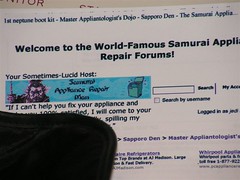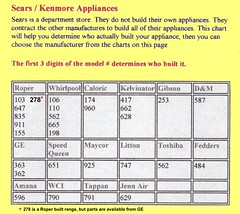2. New Blog Posts During October
3. The Samurai Appliance Repair Forums
The biggest news this month is the total make-over of Fixitnow.com. You can read about all the details in this post but what I want to emphasize here are the key changes in the site as they affect your efficiently finding the appliance repair information you need.
First thing is the new site search box, on the top right-hand side, just below the logo. This is a built-in search engine, not a third-party Yahoo or Google search. That means it’s much more detailed, comprehensive, and up-to-date than a third-party search utility could ever be. Use it! Alot! You can start with a specific search term, such as “Kenmore model 417.36465 dryer will not get hot.” If you don’t get any results or nothing answers your question, then zoom out to more general search terms such as, “dryer no heat.”
Just below the site search utility in the right-hand sidebar is the LivePerson box. If I’m online, you’ll see a face in the box. Click it and I can help you find stuff. For more detailed help, start a new topic in the repair forum. In fact, that’s the first of the three main sections just below the LivePerson box. Let’s go ahead and talk about those.
You’ll find the three sections immediately below the LivePerson box to be particularly illuminating. They are:
1) The Awesome Do-It-Yourself Forums
The first section is a link to the World-Famous Samurai Appliance Repair Forums where you’ll get personalized help from myself and other master appliance techs who can help you troubleshoot and repair any major appliance.
2) Appliance Troubleshooting Help
This is a list of links by appliance to the repair help section of our parts partner’s website. They have lots of great illustrations, diagrams, and diagnostic information at their site and you can turn around and buy the part right there. Hey, why reinvent the wheel?
3) Key Pages
These are static pages (i.e., non-blog pages) with commonly sought-after information.
Just below this is the section of Post Categories. Here, you can browse all the posts in a category, such as “Dryer Repair,” “Washer Repair,” etc.
Another change is that future non-appliance repair posts, such as my libertarian rants, Hillstomping Updates, and philosophical ramblings will be posted in my new personal blog, The Zenzoid Files. If you get bored jamming bamboo splints under your toe nails, come check out the train wreck at www.zenzoid.com.
2. New Blog Posts During October
October was a very heavy month for blog posts, 34 total, and almost all of them focused on some aspect of appliance repair– too many to list or summarize; to list them would be unusually cruel and boring, and to summarize them would be a frivolous exercise in wasting time. But you can easily and quickly browse them yourself by checking out the October archive. Here’s another cool feature of WordPress, the new publishing software I’m using for Fixitnow.com: the monthly archive pages contain summaries of each post during that month, not the complete, full-length post, a la Blogger, my old publishing system. While skimming the archive page, just click on the title to read the full article.
3. The Samurai Appliance Repair Forums
The Samurai Appliance Repair Forums are rockin’. Here are a few summary stats on the forum for the month of October:
Visitors, total: 2,266
Visitors per day (average): 73
New Posts: 2,705
New Posts per day (average): 87
Lots of folks are going to the repair forum and getting stuff fixed. And they should. It truly is the premiere appliance repair forum on the web with an unrivalled lineup of master appliance techs from all over the world who donate their time to help grasshoppers with their vexing appliance problems.
I always think it’s obvious that you can buy parts through my website; in fact, I don’t like to be in-your-face about it because it could detract from the ambiance of the site. But I’m always shocked when I find out, usually either in the repair forum or in an email exchange, that someone had no idea that they could buy parts through my website. This just in from the newswires: FLASH– IF YOU NEED APPLIANCE PARTS, BUY THEM THROUGH THE PARTS LINKS AT FIXITNOW.COM.
I know, you’re wondering why you should buy parts through my parts links instead of buying somewhere, anywhere, else. Fair questions, I’ll give you three reasons:
1) The prices are as good or better than you’ll find anywhere else.
2) But on top of great prices, you get world-class customer service and the best return policy anywhere: you can return any part for any reason. Period. Yep, even electronic or electrical parts that have already been installed and, oops!, that didn’t fix the problem (but allow me to remind you, gentle reader, of Samurai’s Ichiban Law of Appliance Repair).
3) My website and repair forum survive because do-it-yourselfers like you buy their replacement parts through my affiliate links. Whether you buy the parts through my parts links or go directly to my parts partner, RepairClinic, it doesn’t cost you any extra, the only difference is that if you go through my links, I get a small commission on the sale. Hey, a few pennies here, a few pennies there and before you know it, I have enough money for a bomber can of Bud.
But, in addition to the foregoing, they really do have some very good repair information over there. For your convenience (because that is all ever think about), I’ve included the list of links to the appliance repair troubleshooting sections at RepairClinic:
- Air Conditioners
- Dehumidifiers
- Dishwashers
- Disposals
- Dryers
- Freezers
- Ice Makers
- Microwave Ovens
- Ovens, Ranges, and Stoves
- Refrigerators
- Trash Compactors
- Washing Machines
Finally I just want to thank you for visiting Fixitnow.com and making it a part of your Internet experience. There are bizzillions of websites out there and I’m glad you found ours!

 Once upon a time, in a place that was called the "land of the free," there was a big ol’ company called Dupont. Now, Dupont made a thang that we old timers held near and dear to our hearts and that was R-12, a refrigerant used in just about every type of refrigerator ever made, including beer coolers. But Dupont had a problem: their patent on R-12 was about to expire and everyone else and their momma was gonna start making it, too. Well, it don’t take a rocket scientist, like yours truly, to figger out that once this happened, the price of R-12 was gonna take a nose dive.
Once upon a time, in a place that was called the "land of the free," there was a big ol’ company called Dupont. Now, Dupont made a thang that we old timers held near and dear to our hearts and that was R-12, a refrigerant used in just about every type of refrigerator ever made, including beer coolers. But Dupont had a problem: their patent on R-12 was about to expire and everyone else and their momma was gonna start making it, too. Well, it don’t take a rocket scientist, like yours truly, to figger out that once this happened, the price of R-12 was gonna take a nose dive.  Anyway, Dupont goes and presents all these high falootin’ studies to one of the fourth branches of the gubmint, the EPA. The EPA said, "Hmmm, we can’t be eatin’ up all them little orzos like that there. Gubmint has to do something about that!" So they came out with a big ol’ riot act of new regamalations where they said everyone what works on beer coolers has to have a new-fangled recovery unit to catch all them bad molecules.
Anyway, Dupont goes and presents all these high falootin’ studies to one of the fourth branches of the gubmint, the EPA. The EPA said, "Hmmm, we can’t be eatin’ up all them little orzos like that there. Gubmint has to do something about that!" So they came out with a big ol’ riot act of new regamalations where they said everyone what works on beer coolers has to have a new-fangled recovery unit to catch all them bad molecules. 

